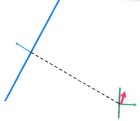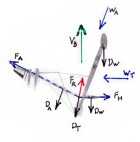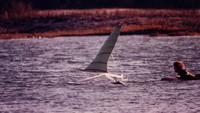High-Speed Sailing
| Vessel Name: | Sailien |
| Vessel Make/Model: | Experimental/custom |
28 September 2013
The America’s Cup
I watched, with interest, the videos of the 34th America’s Cup. At last we have fast sailboats engaged in a competition that is fun to watch. The virtual images (such as course boundaries, distance grid lines, separation between boats, etc.) overlaid on the real images really helps to keep the race [...]
31 August 2013
100 Knots for Hydroptere?
The latest news from Hydroptere is that they have plans for a 100 knot sailboat. This was posted on 26 Aug 2013, so look for that date at this address. http://hydroptere.com/en/the-news/last-news/
17 November 2012
Aptly named Sailrocket, blasts off!
While yet to be ratified, Sailrocket posted an average speed over 500 meters of 59 knots. I will not be surprised if they increase their record into the 60 knot range during this record attempt.
02 January 2012
More drag for VSR2?
I want to start by pointing out that the whole VSR2 team has done a stellar job and has demonstrated conclusively that the forces that drive a sailboat can be aligned for roll stability without using ballast and without using any down-force. (Trifoiler achieved roll stability by using down-force, but [...]
18 December 2011
My analysis of Sailrocket
I copied a diagram of VSR2 (wing doesn’t show well) and added in the major force arrows that apply. Be aware that these arrows are not correct in terms of scale (length) and some of their locations are guesses, however I believe I’m correct enough for us to learn something about what VSR2 has been [...]
23 October 2011
60 is within reach, what’s next?
I have been watching Sailrocket’s progress with great interest and there’s no question they have a winner. I fully expect to see them reach 60kt in the near future. Sailrocket has now demonstrated what I first learned with my models and again with my full-sized prototypes, that if you get the forces [...]
Planing verses Foiling
Let me back up a bit and point out that a major barrier to high-speed sailing is the water. This is due to the density of the water and its resistance to an object moving through it at high speed. Don't overlook the fact that aircraft have the same problem in moving rapidly through the air; it's just that air is less dense than water so there is less resistance until very high speeds are reached.
I have been saying that the #1 problem for high-speed sailing is stability, but the #2 problem is drag (the resistance to the motion of an object through a fluid, be it water or air). I will discuss both of these problems a bit. Stability has traditionally been handled by using weight in some form or another to counter-balance the sail. Let's assume we have adequate stability for our craft but we want to go faster. Our problem now becomes how do we minimize drag. Since we know that the water itself is the biggest barrier, it is easy to see that the less we contact and disturb it, the less drag we will have.
We need to minimize water contact to decrease drag, and we have a few ways to do this. One would be to decrease the craft's weight. Another would be to raise the craft partly out of the water (we can't totally disconnect from the water and still go fast as I explained in earlier posts). There are four ways to raise our sailing craft that I can think of. One is by using "negative weight", such as Bernard Smith's use of helium in his "Sailloons, one is by hydro-planing, one is by hydro-foiling and one is by aero-foiling.
I'll not discuss "negative weight", since none of the contenders appear to be using it. All of the contenders are hydro-foiling with respect to leeway resistance, but only Hydroptere and Wotrocket are hydro-foiling to raise the hull out of the water. Earlier Trifoiler was hydro-foiling the hull up, but is not currently a contender; there have been others and there will be more. The hydro-planers include Innovation, Sailrocket, windsurfers and kite-boarders. Additionally, Sailrocket is using aero-foiling to raise the craft (the cross-arm foil) and they managed to fly the craft but demonstrated how that's not the fastest way to sail.
The advantage of planing is that the water surface is what you are planing on, and with a good set-up the craft will be stable since it remains in contact with the surface. Generally speaking, planing is the simplest way to raise the hull and keep it stable. The advantage of hydro-foiling is that it provides a better lift/drag ratio than planing (a foil will have less drag than a plane, when lifting the same amount of weight). The correct aero-foil used for raising the hull should produce less drag than a hydro-foil at high speeds (due to less density).
The disadvantages of planing are a poorer L/D ratio and any chop in the water will "pound" against the plane, increasing drag (hence the search for ideal speed-sailing conditions with smooth water). Hydrofoils are not so dependent on smooth water, since they work below the surface of the water. For this reason Hydroptere and Wotrocket are able to sail in rougher water. A disadvantage of hydrofoils is that some means must be used to keep the desired ride height constant to maintain stability. Trifoiler has a good solution with its "feelers" that reference and automatically maintain ride height. Surface-piercing hydrofoils can be used to maintain proper ride height, since as the craft rises; less foil is in the water producing less lift.
Using aero-foils to lift the craft again provides us with the problem of maintaining ride height. We were given a dramatic demonstration of what happens when the ride height is not maintained with Sailrocket's flip.
At this point I'd like to once again state that in my view, stability of a high-speed sailboat is a designer responsibility and the crew's job should be to control direction, acceleration/deceleration and trim.
Bob
About & Links
- Bob's Surfing Blog
- Bob's Website
- Greenbird (Windjet)
- l'Hydroptere
- Le Projet Dared
- Macquarie Speed Sailing Team
- Monofoil Sailing
- Mountain Goat STOL
- Mr Smith's Amazing Sailboats
- Patent Office (Search)
- Radboat
- Sailien Prototypes (early), Delta, etc.
- Sailien Video
- Sailien Website
- The Basics of Surfboard Design
- The Basics of Surfboard Design en Espanol
- The Swedish Speed-Sailing Challenge
- Trifoiler
- Vestas Sailrocket
- Windjet Project
- WSSRC


